#disability history
Text
This is just a not-so friendly reminder to non-disabled people, especially authors, people in fandoms or in media analysis circles: Cripple/crippled is not just a fancy way of faying "badly injured". it's not an adjective you can just throw in to spice up your sentence because you used "injured" or "disabled" too many times in that paragraph, or because you feel like it gives your writing some extra "oomph".
Cripple is a slur.
A slur the physically disabled community has been asking people not to use for DECADES, since at least the 1970's (50 years). It's a slur with centuries of abuse behind it, centuries of being used to justify physically disabled people as less-than, centuries of demonisation, mistreatment, ostracization, and murder.
Some people within the physical disability community are reclaiming it, that's where movements like cripplepunk (also known as crip-punk or C-punk) come from. That's fine, I'm not talking about that. I love the cripplepunk movement and everything it stands for: being unapologetic about our disabilities and not changing ourselves for the comfort or convenience of able-bodied folks. But the people who use it in that context understand the history of the word, they know how it was used to hurt us, and they understand that not everyone in the physically disabled community is comfortable with the use of the word, especially those who were around when someone being labelled as "crippled" was seen as a valid reason to treat them as less than human. They understand the impact of the word.
But If you, as an able bodied person, casually uses "cripple" in your work, at best you are showing your disabled audience that you haven't been listening to us, at worst, you show you don't care about weather we feel safe in the spaces you have created.
And for able-bodied authors specifically, even if your character is physically disabled, I'd still recommend avoiding it unless you're prepared to do a LOT of sensitivity readings from multiple sensitivity readers. I've been physically disabled since I was 1 year old, I learned to walk for the first time in prosthetics and have been using a wheelchair since I was in school, I have no memory of life as an able-bodied person, and even I don't feel comfortable using the word cripple in my work.
It's a loaded word, with a lot of implications and a LOT of very dark, and for some people, very recent history. It's not a sentence enhancer to just throw in willy-nilly. Please.
#Writing Disability with Cy Cyborg#disabled#disability#disability history#ableism#physically disabled#cripple punk#cpunk#actually disabled#physical disability#visibly disabled#visible disability#writing disability#writing#writing community#writeblr#writers of tumblr#authors of tumblr#media analysis#write#c slur#language
3K notes
·
View notes
Text
Available as an open-access PDF via the publisher or @jstor, this sourcebook takes in a wide range of genres to look at histories of disability in medieval Europe. You can also get a hard copy for under $30 if you feel like supporting an indie publisher. Any royalties are donated to causes related to disability justice.
2K notes
·
View notes
Text
The Disability Library
I love books, I love literature, and I love this blog, but it's only been recently that I've really been given the option to explore disabled literature, and I hate that. When I was a kid, all I wanted was to be able to read about characters like me, and now as an adult, all I want is to be able to read a book that takes us seriously.
And so, friends, Romans, countrymen, I present, a special disability and chronic illness booklist, compiled by myself and through the contributions of wonderful members from this site!
As always, if there are any at all that you want me to add, please just say. I'm always looking for more!
Edit 20/10/2023: You can now suggest books using the google form at the bottom!
Updated: 31/08/2023
Articles and Chapters
The Drifting Language of Architectural Accessibility in Victor Hugo's Notre-Dame de Paris, Essaka Joshua, 2012
Early Modern Literature and Disability Studies, Allison P. Hobgood, David Houston Wood, 2017
How Do You Develop Whole Object Relations as an Adult?, Elinor Greenburg, 2019
Making Do with What You Don't Have: Disabled Black Motherhood in Octavia E. Butler's Parable of the Sower and Parable of the Talents, Anna Hinton, 2018
Necropolitics, Achille Mbeme, 2003 OR Necropolitics, Achille Mbeme, 2019
Wasted Lives: Modernity and Its Outcasts, Zygmunt Bauman, 2004
Witchcraft and deformity in early modern English Literature, Scott Eaton, 2020
Books
Fiction:
Misc:
10 Things I Can See From Here, Carrie Mac
A-F:
A Curse So Dark and Lonely, (Series), Brigid Kemmerer
Akata Witch, (Series), Nnedi Okorafor
A Mango-Shaped Space, Wendy Mass
Ancillary Justice, (Series), Ann Leckie
An Unkindness of Ghosts, Rivers Solomon
An Unseen Attraction, (Series), K. J. Charles
A Shot in the Dark, Victoria Lee
A Snicker of Magic, Natalie Lloyd
A Song of Ice and Fire, (series), George R. R. Martin
A Spindle Splintered, (Series), Alix E. Harrow
A Time to Dance, Padma Venkatraman
Bath Haus, P. J. Vernon
Beasts of Prey, (Series), Ayana Gray
The Bedlam Stacks, (Series), Natasha Pulley
Black Bird, Blue Road, Sofiya Pasternack
Black Sun, (Series), Rebecca Roanhorse
Blood Price, (Series), Tanya Huff
Borderline, (Series), Mishell Baker
Breath, Donna Jo Napoli
The Broken Kingdoms, (Series), N.K. Jemisin
Brute, Kim Fielding
Cafe con Lychee, Emery Lee
Carry the Ocean, (Series), Heidi Cullinan
Challenger Deep, Neal Shusterman
Cinder, (Series), Marissa Meyer
Clean, Amy Reed
Connection Error, (Series), Annabeth Albert
Cosima Unfortunate Steals A Star, Laura Noakes
Crazy, Benjamin Lebert
Crooked Kingdom, (Series), Leigh Bardugo
Daniel Cabot Puts Down Roots, (Series), Cat Sebastian
Daniel, Deconstructed, James Ramos
Dead in the Garden, (Series), Dahlia Donovan
Dear Fang, With Love, Rufi Thorpe
Deathless Divide, (Series), Justina Ireland
The Degenerates, J. Albert Mann
The Doctor's Discretion, E.E. Ottoman
Earth Girl, (Series), Janet Edwards
Everyone in This Room Will Someday Be Dead, Emily R. Austin
The Extraordinaries, (Series), T. J. Klune
The Extraordinary Education of Nicholas Benedict, (Series), Trenton Lee Stewart
Fight + Flight, Jules Machias
The Final Girl Support Group, Grady Hendrix
Finding My Voice, (Series), Aoife Dooley
The First Thing About You, Chaz Hayden
Follow My Leader, James B. Garfield
Forever Is Now, Mariama J. Lockington
Fortune Favours the Dead, (Series), Stephen Spotswood
Fresh, Margot Wood
H-0:
Harmony, London Price
Harrow the Ninth, (series), Tamsyn Muir
Hench, (Series), Natalia Zina Walschots
Highly Illogical Behaviour, John Corey Whaley
Honey Girl, Morgan Rogers
How to Become a Planet, Nicole Melleby
How to Bite Your Neighbor and Win a Wager, (Series), D. N. Bryn
How to Sell Your Blood & Fall in Love, (Series), D. N. Bryn
Hunger Pangs: True Love Bites, Joy Demorra
I Am Not Alone, Francisco X. Stork
The Immeasurable Depth of You, Maria Ingrande Mora
In the Ring, Sierra Isley
Into The Drowning Deep, (Series), Mira Grant
Iron Widow, (Series), Xiran Jay Zhao
Izzy at the End of the World, K. A. Reynolds
Jodie's Journey, Colin Thiele
Just by Looking at Him, Ryan O'Connell
Kissing Doorknobs, Terry Spencer Hesser
Lakelore, Anna-Marie McLemore
Learning Curves, (Series), Ceillie Simkiss
Let's Call It a Doomsday, Katie Henry
The Library of the Dead, (Series), TL Huchu
The Lion Hunter, (Series), Elizabeth Wein
Lirael, (Series), Garth Nix
Long Macchiatos and Monsters, Alison Evans
Love from A to Z, (Series), S.K. Ali
Lycanthropy and Other Chronic Illnesses, Kristen O'Neal
Never Let Me Go, Kazuo Ishiguro
The Never Tilting World, (Series), Rin Chupeco
The No-Girlfriend Rule, Christen Randall
Nona the Ninth, (series), Tamsyn Muir
Noor, Nnedi Okorafor
Odder Still, (Series), D. N. Bryn
Once Stolen, (Series), D. N. Bryn
One For All, Lillie Lainoff
On the Edge of Gone, Corinne Duyvis
Origami Striptease, Peggy Munson
Our Bloody Pearl, (Series), D. N. Bryn
Out of My Mind, Sharon M. Draper
P-T:
Parable of the Sower, (Series), Octavia E. Butler
Parable of the Talents, (Series), Octavia E. Butler
Percy Jackson & the Olympians, (series), Rick Riordan
Pomegranate, Helen Elaine Lee
The Prey of Gods, Nicky Drayden
The Pursuit Of..., (Series), Courtney Milan
The Queen's Thief, (Series), Megan Whalen Turner
The Quiet and the Loud, Helena Fox
The Raging Quiet, Sheryl Jordan
The Reanimator's Heart, (Series), Kara Jorgensen
The Remaking of Corbin Wale, Joan Parrish
Roll with It, (Series), Jamie Sumner
Russian Doll, (Series), Cristelle Comby
The Second Mango, (Series), Shira Glassman
Scar of the Bamboo Leaf, Sieni A.M
Shaman, (Series), Noah Gordon
Sick Kids in Love, Hannah Moskowitz
The Silent Boy, Lois Lowry
Six of Crows, (Series) Leigh Bardugo
Sizzle Reel, Carlyn Greenwald
The Spare Man, Mary Robinette Kowal
The Stagsblood Prince, (Series), Gideon E. Wood
Stake Sauce, Arc 1: The Secret Ingredient is Love. No, Really, (Series), RoAnna Sylver
Stars in Your Eyes, Kacen Callender [Expected release: Oct 2023]
The Storm Runner, (Series), J. C. Cervantes
Stronger Still, (Series), D. N. Bryn
Sweetblood, Pete Hautman
Tarnished Are the Stars, Rosiee Thor
The Theft of Sunlight, (Series), Intisar Khanani
Throwaway Girls, Andrea Contos
Top Ten, Katie Cotugno
Torch, Lyn Miller-Lachmann
Treasure, Rebekah Weatherspoon
Turtles All the Way Down, John Green
U-Z:
Unlicensed Delivery, Will Soulsby-McCreath
Expected release October 2023
Verona Comics, Jennifer Dugan
Vorkosigan Saga, (Series), Lois McMaster Bujold
We Are the Ants, (Series), Shaun David Hutchinson
The Weight of Our Sky, Hanna Alkaf
Whip, Stir and Serve, Caitlyn Frost and Henry Drake
The Whispering Dark, Kelly Andrew
Wicked Sweet, Chelsea M. Cameron
Wonder, (Series), R. J. Palacio
Wrong to Need You, (Series), Alisha Rai
Ziggy, Stardust and Me, James Brandon
Graphic Novels:
A Quick & Easy Guide to Sex & Disability, (Non-Fiction), A. Andrews
Constellations, Kate Glasheen
Dancing After TEN: a graphic memoir, (memoir) (Non-Fiction), Vivian Chong, Georgia Webber
Everything Is an Emergency: An OCD Story in Words Pictures, (memoir) (Non-Fiction), Jason Adam Katzenstein
Frankie's World: A Graphic Novel, (Series), Aoife Dooley
The Golden Hour, Niki Smith
Nimona, N. D. Stevenson
The Third Person, (memoir) (Non-Fiction), Emma Grove
Magazines and Anthologies:
Artificial Divide, (Anthology), Robert Kingett, Randy Lacey
Beneath Ceaseless Skies #175: Grandmother-nai-Leylit's Cloth of Winds, (Article), R. B. Lemburg
Defying Doomsday, (Anthology), edited by Tsana Dolichva and Holly Kench
Josee, the Tiger and the Fish, (short story) (anthology), Seiko Tanabe
Nothing Without Us, edited by Cait Gordon and Talia C. Johnson
Nothing Without Us Too, edited by Cait Gordon and Talia C. Johnson
Unbroken: 13 Stories Starring Disabled Teens, (Anthology), edited by Marieke Nijkamp
Uncanny #24: Disabled People Destroy Science Fiction, (Anthology), edited by: Elsa Sjunneson-Henry, Dominik Parisien et al.
Uncanny #30: Disabled People Destroy Fantasy, (Anthology), edited by: Nicolette Barischoff, Lisa M. Bradley, Katharine Duckett
We Shall Be Monsters, edited by Derek Newman-Stille
Manga:
Perfect World, (Series), Rie Aruga
The Sky is Blue with a Single Cloud, (Short Stories), Kuniko Tsurita
Non-Fiction:
Academic Ableism: Disability and Higher Education, Jay Timothy Dolmage
A Disability History of the United States, Kim E, Nielsen
The Architecture of Disability: Buildings, Cities, and Landscapes beyond Access, David Gissen
Being Seen: One Deafblind Woman's Fight to End Ableism, Elsa Sjunneson
Black Disability Politics, Sami Schalk
Borderline, Narcissistic, and Schizoid Adaptations: The Pursuit of Love, Admiration, and Safety, Dr. Elinor Greenburg
Brilliant Imperfection: Grappling with Cure, Eli Clare
The Cambridge Companion to Literature and Disability, Barker, Clare and Stuart Murray, editors.
The Capacity Contract: Intellectual Disability and the Question of Citizenship, Stacy Clifford Simplican
Capitalism and Disability, Martha Russel
Care work: Dreaming Disability Justice, Leah Lakshmi Piepzna-Samarasinha
Catatonia, Shutdown and Breakdown in Autism: A Psycho-Ecological Approach, Dr Amitta Shah
The Collected Schizophrenias: Essays, Esme Weijun Wang
Crip Kinship, Shayda Kafai
Crip Up the Kitchen: Tools, Tips and Recipes for the Disabled Cook, Jules Sherred
Culture – Theory – Disability: Encounters between Disability Studies and Cultural Studies, Anne Waldschmidt, Hanjo Berressem, Moritz Ingwersen
Decarcerating Disability: Deinstitutionalization and Prison Abolition, Liat Ben-Moshe
Demystifying Disability: What to Know, What to Say, and How to Be an Ally, Emily Ladau
Dirty River: A Queer Femme of Color Dreaming Her Way Home, Leah Lakshmi Piepzna-Samarasinha
Disability Pride: Dispatches from a Post-ADA World, Ben Mattlin
Disability Visibility: First-Person Stories From the Twenty-First Century, Alice Wong
Disfigured: On Fairy Tales, Disability and Making Space, Amanda Leduc
Every Cripple a Superhero, Christoph Keller
Exile and Pride: Disability, Queerness and Liberation, Eli Clare
Feminist Queer Crip, Alison Kafer
The Future Is Disabled: Prophecies, Love Notes, and Mourning Songs, Leah Lakshmi Piepzna-Samarasinha
Growing Up Disabled in Australia, Carly Findlay
It's Just Nerves: Notes on a Disability, Kelly Davio
The Immortal Life of Henrietta Lacks, Rebecca Skloot
Language Deprivation & Deaf Mental Health, Neil S. Glickman, Wyatte C. Hall
The Minority Body: A Theory of Disability, Elizabeth Barnes
My Body and Other Crumbling Empires: Lessons for Healing in a World That Is Sick, Lyndsey Medford
No Right to Be Idle: The Invention of Disability, 1840s-1930s, Sarah F. Rose
Nothing About Us Without Us: Disability Oppression and Empowerment, James I. Charlton
The Pedagogy of Pathologization Dis/abled Girls of Color in the School-prison Nexus, Subini Ancy Annamma
Physical Disability in British Romantic Literature, Essaka Joshua
QDA: A Queer Disability Anthology, Raymond Luczak, Editor.
The Right to Maim: Debility, Capacity, Disability, Jasbir K. Puar
Sitting Pretty, (memoir), Rebecca Taussig
Sounds Like Home: Growing Up Black & Deaf in the South, Mary Herring Wright
Surviving and Thriving with an Invisible Chronic Illness: How to Stay Sane and Live One Step Ahead of Your Symptoms, Ilana Jacqueline
The Things We Don't Say: An Anthology of Chronic Illness Truths, Julie Morgenlender
Uncanny Bodies: Superhero Comics and Disability, Scott T. Smith, José Alaniz
Uncomfortable Labels: My Life as a Gay Autistic Trans Woman, (memoir), Laura Kate Dale
Unmasking Autism, Devon Price
The War on Disabled People: Capitalism, Welfare and the Making of a Human Catastrophe, Ellen Clifford
We've Got This: Essays by Disabled Parents, Eliza Hull
Year of the Tiger: An Activist's Life, (memoir) (essays) Alice Wong
Picture Books:
A Day With No Words, Tiffany Hammond, Kate Cosgrove-
A Friend for Henry, Jenn Bailey, Mika Song
Ali and the Sea Stars, Ali Stroker, Gillian Reid
All Are Welcome, Alexandra Penfold, Suzanne Kaufman
All the Way to the Top, Annette Bay Pimentel, Jennifer Keelan-Chaffins, Nabi Ali
Can Bears Ski?, Raymond Antrobus, Polly Dunbar
Different -- A Great Thing to Be!, Heather Alvis, Sarah Mensinga
Everyone Belongs, Heather Alvis, Sarah Mensinga
I Talk Like a River, Jordan Scott, Sydney Smith
Jubilee: The First Therapy Horse and an Olympic Dream, K. T. Johnson, Anabella Ortiz
Just Ask!, Sonia Sotomayor, Rafael López
Kami and the Yaks, Andrea Stenn Stryer, Bert Dodson
My Three Best Friends and Me, Zulay, Cari Best, Vanessa Brantley-Newton
Rescue & Jessica: A Life-Changing Friendship, Jessica Kensky, Patrick Downes, Scott Magoon
Sam's Super Seats, Keah Brown, Sharee Miller
Small Knight and the Anxiety Monster, Manka Kasha
We Move Together, Kelly Fritsch, Anne McGuire, Eduardo Trejos
We're Different, We're the Same, and We're All Wonderful!, Bobbi Jane Kates, Joe Mathieu
What Happened to You?, James Catchpole, Karen George
The World Needs More Purple People, Kristen Bell, Benjamin Hart, Daniel Wiseman
You Are Enough: A Book About Inclusion, Margaret O'Hair, Sofia Sanchez, Sofia Cardoso
You Are Loved: A Book About Families, Margaret O'Hair, Sofia Sanchez, Sofia Cardoso
The You Kind of Kind, Nina West, Hayden Evans
Zoom!, Robert Munsch, Michael Martchenko
Plays:
Peeling, Kate O'Reilly
---
With an extra special thank you to @parafoxicalk @craftybookworms @lunod @galaxyaroace @shub-s @trans-axolotl @suspicious-whumping-egg @ya-world-challenge @fictionalgirlsworld @rubyjewelqueen @some-weird-queer-writer @jacensolodjo @cherry-sys @dralthon @thebibliosphere @brynwrites @aj-grimoire @shade-and-sun @ceanothusspinosus @edhelwen1 @waltzofthewifi @spiderleggedhorse @sleepneverheardofher @highladyluck @oftheides @thecouragetobekind @nopoodles @lupadracolis @elusivemellifluence @creativiteaa @moonflowero1 @the-bi-library @chronically-chaotic-cryptid for your absolutely fantastic contributions!
---
Submit a Book:
#disability resources#disability#chronic illness#disability books#books#resources#book list#disability literature#literature#disability representation#disabled characters#information#informative#disability education#disability history#disability rights#please add to this#to be updated#long post
2K notes
·
View notes
Text
You know what makes me sad?
It makes me sad, and not a little bit mad, that there are disabled people -- even those who are Disability Advocates -- who hate Disability Pride Month because they're convinced it was invented by normate people to make themselves feel better. I suspect that's because it follows directly after June's Queer Pride Month, and, if you are young enough to not remember the history for yourself ('cause we all know it's not being taught n schools), it can feel like a leftover crumb. But it is so, so, not.
If I were Queen of Calendars, I might move Disability Pride Month to April, to commemorate the 504 Sit-in of 1977, especially the occupation of the regional offices of Health, Education, and Welfare in San Fransisco, by over 500 people, mostly disabled (with their personal care assistants). The Occupation lasted 28 Days -- the longest protest occupation of a federal building in U.S. History. Since Queer Pride Month commemorates a protest, maybe Disability Pride Month should, too. The biggest knock against April is the weather is still iffy in much of the country for pride parades and outdoor gatherings.
(Section 504 of the Rehabilitation Act of 1973 was the legal predecessor of the ADA. And no, that's not a typo. Most of the Rehabilitation Act of 1973 was passed in 1973, but the one section that outlined rights for the disabled was put to the side, and ignored for four whole years, because it was deemed to be too expensive and confusing to extend civil rights to disabled people. It was the Sit-In in 1977 that finally pushed President Carter to sign it, and make it law).
Here's a retrospective report on the Sit-In from CBS news, that aired in the '80s (Auto-generated captions):
youtube
(the video is 6 minute, 12 seconds. But the news report ends at 5 minutes 42 seconds)
#disability pride month#disability history#U.S. History#civil rights protest#CBS evening news (vintage)#Section 504 of the Rehabilitation Act of 1973#504 sit-in#youtube (auto generated captions)#Youtube
942 notes
·
View notes
Text
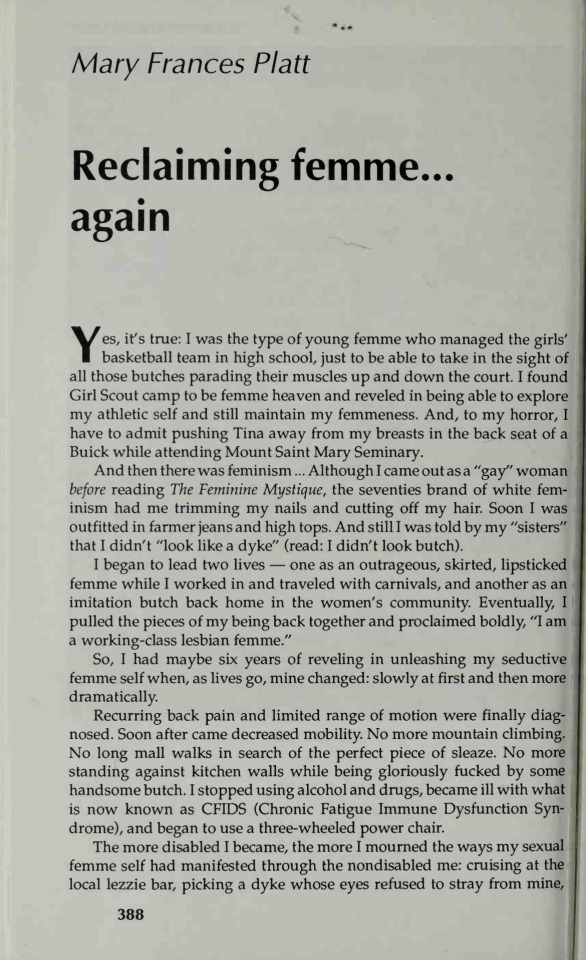

"Yes, it's true: I was the type of young femme who managed the girls basketball team in high school, just to be able to take in the sight of all those butches parading their muscles up and down the court. I found Girl Scout camp to be femme heaven and reveled in being able to explore my athletic self and still maintain my femmeness. And, to my horror, I have to admit pushing Tina away from my breasts in the back seat of a Buick while attending Mount Saint Mary Seminary.
And then there was feminism... Although I came out as a "gay" woman before reading The Feminine Mystique, the seventies brand of white feminism had me trimming my nails and cutting off my hair. Soon I was outfitted in farmer jeans and high tops. And still I was told by my "sisters" that I didn't "look like a dyke" (read: I didn't look butch).
I began to lead two lives- one as an outrageous, skirted, lipsticked femme while I worked in and traveled with carnivals, and another as an imitation butch back home in the women's community. Eventually, I pulled the pieces of my being back together and proclaimed boldly, "I am a working-class lesbian femme."
So I had maybe six years reveling in unleashing my seductive femme self when, as lives go, mine changed: slowly at first and then more dramatically.
Recurring back pain and limited range of mobility were finally diagnosed. Soon after came decreased mobility. No more mountain climbing. No long mall walks in search of the perfect piece of sleaze. No more standing against kitchen walls being gloriously fucked by some handsome butch. I stopped using alcohol and drugs, became ill with what is now known as CFIDS (Chronic Fatigue Immune Dysfunction Syndrome), and began to use a three-wheeled power chair.
The more disabled I became, the more I mourned the ways my sexual femme self had manifested through the nondisabled me: cruising at the local lezzie bar, picking up a dyke whose eyes refuse to stray from mine, dancing seductively, moving all of me for all of her. Cooking: love and suggestion neatly tucked into the folds of a broccoli quiche. Serving my date in varying, sleazy clothing, removing layers as the meal and our passion progressed. And making love... feeling only pleasure as my hips rose and fell under the weight of her. Accomplishment and pride smirked across my face as her wrists finally submitted to the pressure of strong persistent hands. There are the ways I knew to be femme, to be the essence of me.
It's been five years now since I began using my wheelchair. I am just awakening to a new reclamation of femme. Yes. I still grieve the way I was, am still often unsure how this femme with disabilities will act out her seduction scenes. I still marvel when women find passion amidst the chrome and rubber that is now a part of me.
There have been numerous dates, lovers, relationships, sexual partners, and fliterations along the way. Cindy, Jenny, Ellie, Emma, Diane, Dorothy, Gail, June, Clove, Lenny, Cherry, Diana, Sarah I, and Sarah II. You have all reminded me in your own subtle or overt, quit or wild ways that I am desirable, passionate, exciting, wanted.
Yes I am an incredibly sexual being. An outrageous, loud mouthed femme who's learning to dress, dance, cook, and seduce on wheels; finding new ways to be gloriously fucked by handsome butches and aggressive femmes. I hang out with more sexual outlaws now- you know, the motorcycle lesbians who see wheels and chrome between your legs as something exciting, the leather women whose vision of passion and sexuality doesn't exclude fat, disabled me.
Ableism tells us that lesbians with disability are asexual. (When was the last time you dated a dyke who uses a wheelchair?) Fat oppression insists that thin is in and round is repulsive. At times, these voices become very loud, and my femme, she hid quietly amidts the lists.
Now my femme is rising again. The time of doubt, fear, and retreat has passed. I have found my way out of the lies and oppression and have moved into a space of loving and honoring the new femme who has emerged. This lesbian femme with disabilities is wise, wild, wet, and wanting. Watch out.
-"Reclaiming femme... Yet again" Mary Francis Platt, The Persistent Desire (Edited by Joan Nestle) (1992)
#lesbian#lesbianism#lesbian history#disabled lesbian#lgbt history#gay history#butch femme#femme lesbian#feminism#lesbian feminism#the persistent desire#intersectionality#disability history#disability rights
2K notes
·
View notes
Text

A piano designed to be able to be played by the bedridden. Both the bed and piano are able to be rolled together for use.
If I understand correctly, it could also be used in the typical piano set-up, but if you weren't bedridden and had the option to play the piano from your bed, why wouldn't you?
#disability#disability history#accessibility#accessibility history#accessibility solutions#history#historical photography#medical history#historical photos
391 notes
·
View notes
Text
In the winter of 1990, when the Congressional legislation to turn a proposed Americans with Disabilities Act into law stalled in the House Committee on Public Works and Transportation, hundreds of concerned disability rights activists and others from the affected community descended on Washington, D.C. There, they joined with local activists at the White House and at the U.S. Capitol Building to protest the efforts within government to stall and stop the Act from passing.
The most memorable moment in the winter’s activism happened on March 12, 1990, when dozens of these protestors at the Capitol abandoned their mobility aids and began to climb, crawl, and edge up the steps to the top of the west Capitol entrance on the National Mall. Some climbing on their own and some climbing with help from friends and family, they were cheered on by allies, onlookers, and the press.
This direct action, which forced Congress to see them, is known to history as the Capitol Crawl.

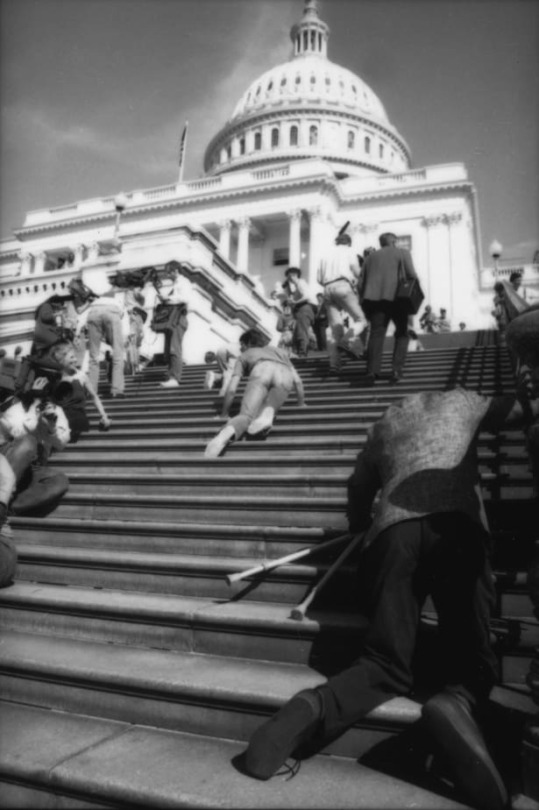

"Jennifer Keelan-Chaffins got on all fours to begin the ascent. Just 8 years old at the time with cerebral palsy, the climb up the stairs took almost an hour. But she was determined.
"As a matter of fact, I said, 'I'll take all night if I have to,'" Keelan-Chaffins told ABC News about that day."
#ADA#disability history#disability right#queer rights#trans rights#childs rights#womens rights#disability protests#ARE disability rights#equality#able bodies#capitol hill crawl#protest#disability rights#history#american history#american protests#usa#politics#did you know
241 notes
·
View notes
Text

I will never be as cool as this man.
(source: Catalog for J. Foot & Son's Rest Chairs, 1913.)
274 notes
·
View notes
Note
Do you have any ideas/evidence as to how skirt length varied for women with limps/disabilities? I'm planning and making a historybounding wardrobe for around 1900-1908, and I am feeling the need to make my skirts, instead of instep length, around ankle-bone length or slightly shorter even than that, just so I don't trip and rip my hems out - at my height it's between 32 and 34 inches. I'm using a lot of plates for "Toilettes de jeune femme ou de jeune fille" for inspo because as a petite 24 year old who looks 16, I can still do that. Looking at various photos of actual normal women it wasn't horribly uncommon to make your skirts four or five or even six inches above the ground, but in high fashion I am drawn to the more sporty skirt styles and evening skirts for dancing for this reason. All of the recorded catalogue skirts are made quite long for quite tall people - to be hemmed as desired.
The thermoregulation is so good with historical dress that if I wear certain underwear and layer properly, I don't get full body spasms and pain at the slightest breeze. It's lovely, but I also need to get around effectively.
I'm so glad it works well for you re: thermoregulation! And of course, being in fact a modern lady, you're not bound to strict historical accuracy if you need to modify things to allow for easier movement.
(Even most normal- non-rich, I imagine you mean? -women often wore instep-length skirts, though, with modifications as needed for work and/or sporting activities. That's probably where you're seeing the shorter hems)
Women with mobility issues did exist back then, of course, but I'm afraid I don't know much about how they may have modified their skirts. Princess Alexandra had a limp after a bout of post-partum rheumatic fever left her with a stiff leg in 1867, but her skirts generally seem to be of normal length in photos. Of course, those are official portraits, and her nature as a public figure means that any image of her would be tightly controlled. she couldn't avoid limping in IRL public appearances, though, which I assume is how it was known generally. there's a rumor that ladies began limping on purpose to copy her, for Fashion Reasons, but that sounds a bit far-fetched to me.
I'd imagine that, much like in working situations, the rule was "practicality first?" Sorry I couldn't be more helpful on the history here!
103 notes
·
View notes
Text
The Jaws Effect and what it means for media representation
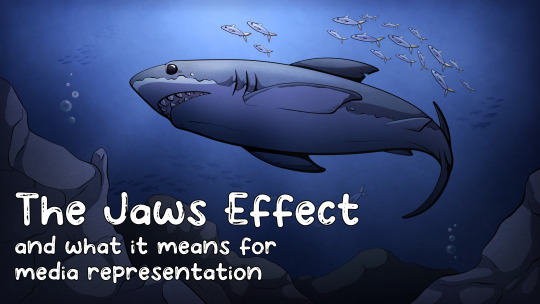
The Jaws Effect is the name of a phenomenon that described the panic and fear that sprang up around sharks, fuelled by Steven Spielberg's movie, Jaws. While the fear of sharks and other marine predators had always been a thing, Jaws launched the fear of sharks, and Great White Sharks in particular, to new (and mostly unfounded) heights. Most people will never encounter a real-life shark and so their only knowledge about the creatures come from movies and other forms of entertainment. Entertainment that largely portrayed them as mindless, unfeeling killing machines. After Jaws, sharks became a staple in the creature-feature genre of movies, which only perpetuated the idea of sharks as dangerous monsters even further, reigniting and reconfirming the beliefs the public held about them in the process. These ideas about sharks are, of course, not true, but the misconception and fear has had a real, observable impacts on shark populations, shark conservation efforts and even laws and legislations surrounding sharks and shark conservation around the world.
Ok but Cy, this is a blog about disability and disabled representation, what do sharks have to do with anything you talk about? Well, Because The Jaws Effect is just one of many examples that shows how massive of an impact representation in the media can have, for better or for worse, especially when talking about subjects the public generally knows very little about.
This conversation is not unique to disability representation, nearly every person I've seen who's talked about how to write and design characters from any minority brings it up eventually, but the media we consume, the movies we watch, the books we read can all have big impacts on people's perceptions on those topics. When talking about disability specifically, it's an unfortunate reality that not many people know all that much about us, and so, much like sharks, for many, their only real exposure to disabled people is through the media they consume.
If you don't know anyone in a wheelchair, and your only knowledge of life as a wheelchair user comes from books and movies like Me Before You, of course you're going to (spoiler) come away thinking that life in a wheelchair is horrible and death is better than living like that. If you don't know any DID Systems and your only exposure to a condition like that is through movies like Split (and honestly, a number of other horror movies and crime shows) of course you'll think people with DID are unstable monsters who could become violent any moment. If your only exposure to autistic people is Music, then it's not shocking that you might think Autistic people are "trapped in their own minds," completely unaware of the world around them and lacking any kind of agency. As much as I'd like to be able to say these are "just movies" or "just books," and that if we don't like them, we can just not watch them, they all had an impact on the real world and real people's perceptions of the disabilities they depicted, as do the many, many smaller examples of bad representation.
This is why I personally spend so much time focused on the portrayal of disability in the media, why so much of my content is focused on creating resources for creators to represent us better, and why I think writers, artists and other types of creators should care about the representation they include.
Unfortunately, people believing misinformation and stereotypes, while annoying, isn't the worst of the impacts bad rep can have. If a stereotype is prevalent enough, and enough people believe it, it can both put us in harms way and cause us to loose access to things we desperately need and things designed to help us. One really common example of this is when movies and TV shows show a character getting up out of their wheelchair, and use this as proof that the person is faking being disabled. However, in reality, there are many disabilities that might mean someone has to use a wheelchair, even if they can still walk a little bit or stand up. The stereotype of someone standing up from their chair being a fake, especially when it's reinforced over and over again in the media, leads non-disabled people to believe that anyone who stands up from their wheelchair is faking, and results in a lot of real disabled people being harassed and denied things like access to disabled parking, toilets and other accessible spaces. There were even a few cases of people reporting those they see get out of their wheelchairs to Centrelink (The Australian "welfare" department, for those not familiar) as frauds, and while these investigations don't usually go far before someone realises what's happened, it has, on occasion, resulted in people loosing the income they depend on to survive, even temporarily.
But the impact of representation, of course, can go both ways.
I was in high school when the first How To Train Your Dragon movie came out, and at the time, I didn't really like people being able to see that I was a leg amputee because I was sick of kids in particular staring, pointing at me, asking their parents "what's wrong with them?" or asking me directly, "what's wrong with your legs?". I wore long skirts and big, bulky tracksuit pants to keep my legs covered, something that became dangerous in the hot Australian summer, but I didn't care.
But the impact of How to Train Your Dragon came in two ways. The first, was that it was one of the first times I'd seen an amputee (or rather, multiple amputees) who didn't keep their prosthetics covered or hidden, and it gave me the little boost in confidence I needed to do that myself and wear clothing that was more comfortable and functional. And second, the comments from children changed, albeit slightly, but enough that it was noticeable. The questions and comments went from "what's wrong with you?" to "oh cool, your legs are like Hiccup's!" I even had one little girl ask me once if I had a pet night fury. They went from being scared of me and my legs, or at the very least concerned for me, to genuinely curious and impressed. While reactions like that did become less and less common over time, they didn't fully go away either. Even today, I occasionally get young kids asking me why I have legs like hiccup. A friend of mine who was born with one arm shorter than the other and without fingers on that side had a similar experience with the movie Finding Nemo. Her disability was a bit more complex than what I described here, and she always found it hard to explain "what happened" to small children, however, after Finding Nemo came out, she was able to simply tell kids "this is my lucky fin, like what nemo has!" and that was enough to take her from someone "scary" to these kids to someone like their favourite characters.
Of course, it's much easier to see the impact positive representation can have on people's perceptions when we're talking about kids media, but it's not exclusive to it either.
When it comes to a minority like the disabled community who are so thoroughly misunderstood by the wider public, misinformation can and does spread easily. What people see and read in the media they consume plays a big roll in how people perceive the real people attached to the stereotypes. We often hear people say "Fiction imitates life" but the reverse can and often is also true, life can imitate and be influenced by fiction, and those of us creating should be mindful of this, especially when we're talking about a group of vulnerable people.
[Thumbnail ID: An illustration of a Great White Shark swimming near the rocky bottom of the ocean, surrounded by silver fish. In the bottom left corner of the image is "The Jaws Effect and what it means for media representation" in big, white bubble text. /End ID]
#Writing disability with Cy Cyborg#Disability 101#Long Post#Disability#Disabled#Disability Representation#Writing Disability#Writing#Writeblr#Authors#Creators#Writing Advice#Disabled Characters#Disability History#On Writing#Disability in Media
762 notes
·
View notes
Text
I think that people often forget that Alexandra suffered from multiple chronic pain conditions, and was disabled. Chronic pain is exhausting, especially without modern medicine and treatments. She spent a great deal of time indoors, unable to move from her rooms, and used a wheelchair. Expecting her to have partaken in manual labour is bizarre and speaks to the sexism and ableism that still pervade this topic of history.
Whatever you think of Alexandra's personality/actions, saying that she was 'stuck up' or 'arrogant' for being physically unable to chop wood is ridiculous. She was disabled.
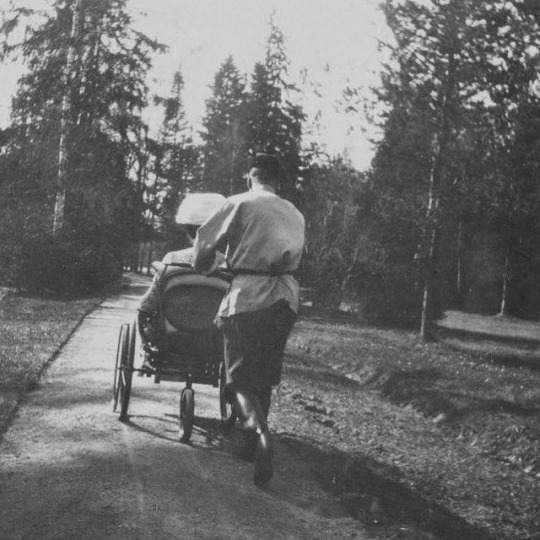


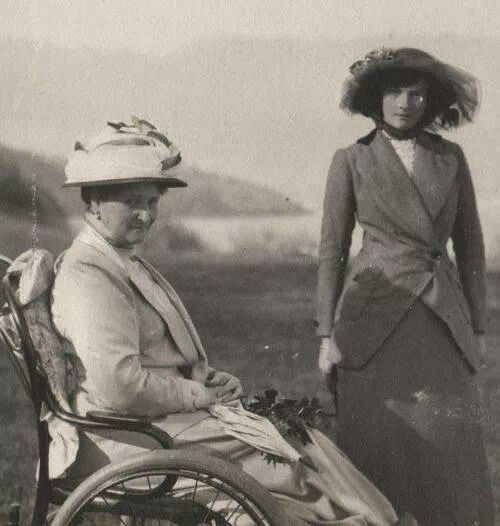
#Alexandra Feodorovna#disability history#disabled historian#I'm TIRED!!#image desc in alt text#cw ableism
55 notes
·
View notes
Text
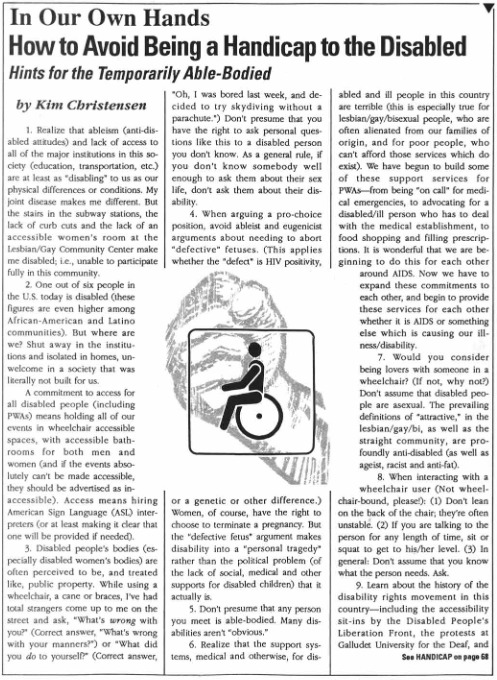

"How to Avoid Being a Handicap to the Disabled: Hints for the Temporarily Able-Bodied" By Kim Christensen, in OutWeek Magazine issue 11 (1989)
#queer history#outweek#cripple punk#actually disabled#ableism#disability rights#disability activism#disability history#cpunk
421 notes
·
View notes
Note
So whenever your disability pride flag is shared on tiktok, ive noticed people asking why do disabled people need a pride flag, or saying that we dont deserve one because we are "co opting" the gay pride movement... and i am honestly at a loss at what to say to them
Okay, then: here's some Disability Pride Talking points for you, when you come upon that assumption:
First: The Disability Rights Movement gained steam in the U.S. at the same time as the Civil Rights Movement was advocating for racial equality, and the Women's Rights movement was advocating for gender equality -- all in the same decade as the Stonewall Riots.
Second: it may seem like Disability Pride Month is "copying" Queer Pride Month, because July comes right after June. But the reason we celebrate Disability Pride Month in July is because that's when The Americans with Disabilities Act was signed: on July 26, 1990. This was the first Disabilities Rights act in the world. It was followed in 1995 by the Disabilities Discrimination Act in the U.K., and in 2019 in Canada.
Third: on April 5, 1977, the (American) Nationwide 504 Sit-in (Wikipedia article) began, to protest the fact that three presidents in a row had been stalling for four years to implement Disability Civil Rights legislation. Disability advocates staged sit-ins in Federal Buildings for the Department of Health, Education, and Welfare, in Atlanta, Boston, Chicago, Denver, Los Angeles, New York City, Philadelphia, and Seattle, San Fransisco, and Washington D.C..
The sit-in in Washington D.C. lasted 28 hours. The Sit-in in San Fransisco lasted 25 Days, and remains the longest occupation of a Federal Government building in U.S. History (It was epic). The civil rights group The Black Panthers also helped with logistical support.
The police tried to force the people inside to leave by cutting phone lines, forgetting that there were people who knew American Sign Language both inside the building, and outside, in the crowd, and they relayed messages back and forth through the windows (excuse me while I take a Cackle break).
Finally: Disabled people are human beings, and deserve all the human rights as everyone else. But a lot of people in authority, look at our lives from the outside, decide that we already have a low-quality of life (without actually asking us), and deciding that it wouldn't be so bad if we died. You know, at the start of the COVID-19 outbreak in this country, it was a fairly common policy that if hospitals ran low on ventilators, they'd just take them from disabled people who needed to use them every day? Remember that?
That's why we have to get loud.
#Disability Pride Month ♿#Disability History#just a few talking points#there are many more#Covid-19#Rationing health care#eugenics#''quality of life''#nothing about us without us
4K notes
·
View notes
Text
My sister found and gifted me this book from 1978, which is surprisingly woke for its time.
For reference, Section 504 of the Rehabilitation Act passed in 1973. The last ugly law was repealed in 1974. The ADA wasn’t signed into law until 1990.
I loved seeing this woman with arthritis using the same type of assistive device I use for my arthritis
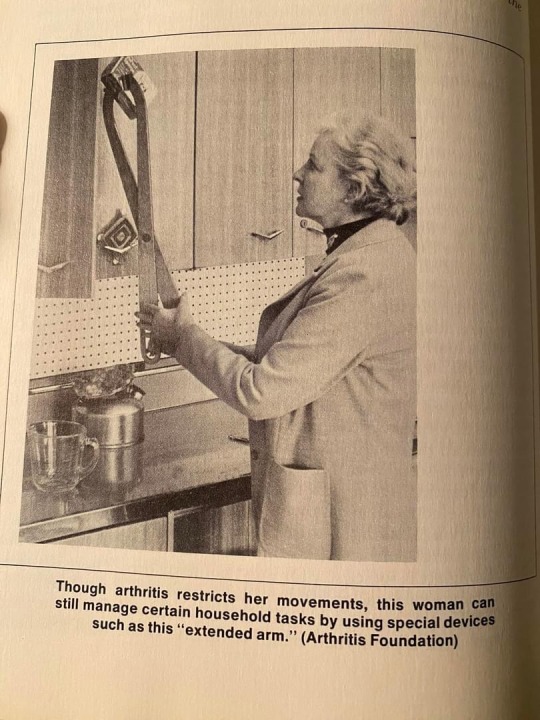

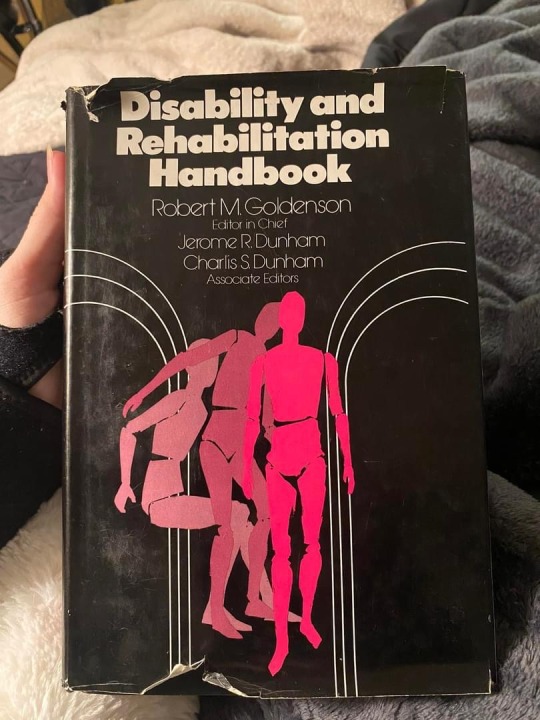
#chronically couchbound#disability#disabled#cripplepunk#cripple punk#disabled pride#disability pride#disabled liberation#disability and rehabilitation#ada#section 504#disability rights#disability history#disabled history
53 notes
·
View notes
Text
Judy Heumann passed away on March 3rd, 2023
She said she believed it was her parents’ experience [fleeing from Nazi Germany and the Holocaust as children] that led them to reject doctors’ advice to have their daughter institutionalized after she contracted polio and lost the use of her legs. “They came from a country where families got separated, some children sent away, others taken from their families by the authorities and never returned — all part of a campaign of systematic dehumanization and murder,” she wrote in her memoir, “Being Heumann.” “Their daughter, disabled or not, wasn’t going anywhere.”
If you have Netflix, Heumann is in Crip Camp, an amazing documentary on disability rights.
Here is her website that lists her publications, including her recent 2020 memoir called "Being Heumann" (please do not pirate her publications out of respect. Buy them or find them at a library).
This woman is one of the main reasons why disabled children in the US can attend public school. She fought for accessibility in Federal buildings and work places before fighting for the ADA, for accessibility in all spaces.
I am heartbroken to hear of her passing. She has impacted the lives of millions if not billions of people for the better. May her memory be a blessing.
#disability#disabled#disability rights#disability activism#disability advocacy#disability history#judy heumann#historical figures#womens history#womens history month#jewish women#disabled women
169 notes
·
View notes
Text
I saw a chained post of the "we should learn more disability history!1!" variety. And... yes. Also, as always, there are much better ways to do so than on Tumblr. I'm starting with this standard text covering US history and available for under $20, as well as at many libraries. Because Tumblr hates posts with multiple links, I'll give other resources their own posts, all tagged for disability history.
One of the reasons I like Nielsen's classic textbook: it takes an approach that asks, both insistently and accessibly, what it means to look at "familiar" histories through a disability studies lens, as well as including more of the histories of people with disabilities. Also, the fact that the chapters are fairly self-contained means it's easy to teach with excerpts in survey classes.
73 notes
·
View notes